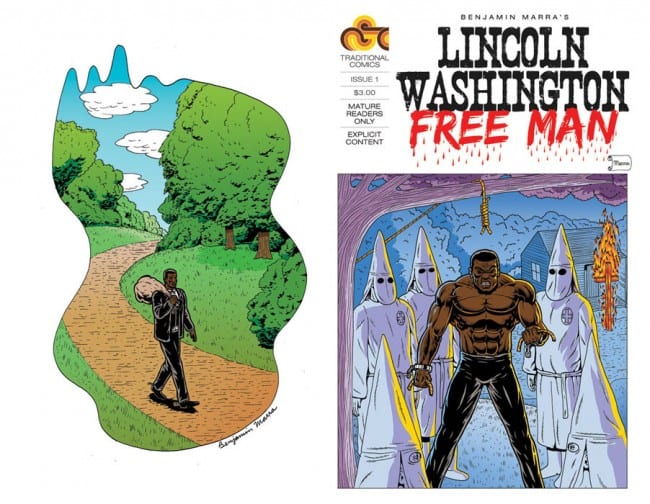
It seems unlikely that anyone would have guessed the missing element Benjamin Marra needed to deliver his first bona fide masterpiece was a dose of realism, but then again he does have a way of confounding expectations. After all, it was always a long shot that the most consistently excellent alternative cartoonist of the post-Kramers Ergot generation would be a purveyor of straight-ahead action serials whose style springs from Paul Gulacy and Todd McFarlane. That’s become the case, though, and now that Marra’s highly idiosyncratic comics have been around long enough to seem… acceptable, if still far from normal, his latest sets about topping the lot.
The Reconstruction-era narrative of a recently freed black man “possessed by the power of a million souls of slaves eternally suffering from lifetimes of racial injustices” (cue trip exclamation points), Lincoln Washington: Free Man features Marra’s signature dynamic plotting and overdriven action, but benefits immensely from its basically factual milieu. Even if the events of this former slave-fights-KKK story are massively amplified for dramatic effect, they all most certainly happened at to someone some point or another, from rapes real and faked to virulent, systematic racism. It’s well and truly impossible for even Marra’s typically over the top plotting to overstate the horrors of slavery and the Jim Crow South, and the sense of legitimacy the setting lends to the book’s explosive conflicts give every squeezed-out eyeball and ripped-off arm a strange gravitas. For the first time, we root for a Marra hero for a reason beside vicarious bloodlust -- everyone who gets dismembered, beheaded, or I-don’t-even-know-if-there’s-a-word-for-getting-the-spine-torn-from-your-living-body-ed richly deserves whatever happens to them, and even worse.
With its literally black-and-white presentation of good versus evil, Lincoln Washington is a superhero comic in all but name, and the book’s artwork entrenches it deeply in American comics’ most popular idiom. Never have Marra’s anatomical distortions looked more Kirbyesque, or his action sequences moved with such speed and vigor, or his panels communicated their content more simply and forcefully. The meticulously detailed renderings of Marra’s early comics are long gone -- the excess is all in the content, and it's the professionalism of hero comics, the craftsmanlike command of form, that's being imported here. But neither measured construction or genre riffing is the most noticeable aspect of the book. Where superhero comics use Nazis as their fallback impossible-to-overstate villains, Marra here continues his streak of using American white racists. It might be just-add-water controversy-baiting, but it also gets at a fundamental truth of violent comics: we read these things to see people who need to feel some pain get got, and the fact that so very few comics feature this type of content makes it all the more urgently necessary.

But as ever with Marra, the masterstroke is in the violence. The strange realism and the ideological legitimacy of the book are both handily matched by career-best action scenes whose scorching brutality go well past anything else the artist has mustered up previously. The remote mechanism of weaponry is almost completely left by the wayside here: the violence featured is obscenely, gloriously hands-on, an orgy of bloodletting that might be the most accomplished reading yet of the age-old “what if someone with superpowers got really fucking pissed and just lashed out” chestnut. It's only after finishing the comic that it emerges as a think piece. While it's going, all a reader can do is grip the newsprint pages with slowly tightening fists.
Underneath the considerable surface thrills of seeing a dude use one Klansman like a baseball bat in order to swat another’s head off, though, is the cold fact that Marra is probably the best there is at what he’s doing right now -- that “alternative comics” may very well be handily beating the mainstream at its own roundhouse-throwing game. Marra’s made a note-perfect choice of subject matter, but the truth is that when an artist is creating something this purely effective, watching their work in motion is consummately satisfying no matter what it gets up to.







